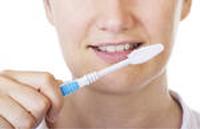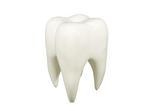Modern dentistry
|
|
Teeth as sparkle your smileMost people know that the teeth are the hardest and strongest part of the body. There's more than meets the eye, though. Teeth are actually a living part of your body that has blood vessels and nerves. If you used to judge your teeth like a book by its cover, then you're in for one big surprise. Teeth anatomy is a lot more complicated than you ever thought. The visible part of a tooth, otherwise known as the crown, is only a small portion of the living system. The crown is made up of enamel, the hardest substance found within the body. It is bone that has been enriched with large percentages of calcium. That's why people who drink lots of milk or take calcium supplements have strong bones and teeth. The enamel is thickest at the crown, and thinnest near the roots of the teeth. Excellent crowns and bridges were made by the Etruscans in the 7th cent. B.C. At about that time, teeth were being extracted in Asia Minor as a cure for bodily ills and diseases. Skills achieved by the Etruscans, Phoenicians, Egyptians, Greeks, and Romans were largely lost during the Middle Ages, when barbers and roving bands of charlatans practiced unskilled dentistry at marketplaces and fairs. Abulcasis, a Spanish Moor, was one of the few in his time who studied dental surgery. Dentures as false teethDentures, also known as false teeth, are the primary topic in this section of our site. Here, you can learn how the procedure is performed, what dentures cost and the advantages and disadvantages of having them. There are two main types of dentures. Both Complete Dentures and Partial Dentures are finely crafted, custom-fitted. If you properly maintain your dentures they will appear natural and provide a perfect smile. Additionally, dentures help strengthen muscles controlling your expressions that require the support of your teeth, rid you of pronunciation problems caused by missing teeth and aid with chewing. If you've lost, or are losing, all of your teeth a Complete Denture is something to discuss with your cosmetic dentist. If some of your teeth remain and are healthy, a partial denture may be your way to a great smile. Veneers solve color and shape teeth problemsThere are several corrections that you can make to the color of your teeth as well as the shape of your teeth! Some of the causes of tooth discoloration are staining, aging, chemical damage, disease, medication, and genetics. Dental Veneers (Tooth Veneers) are used to correct both the color and the shape of teeth. Dental veneers (sometimes called porcelain veneers or dental porcelain laminates) are wafer-thin, custom-made shells of tooth-colored materials designed to cover the front surface of teeth. These shells are bonded to the front of the teeth changing their color, shape, size or length and resulting in an improved appearance. Veneers, porcelain or plastic, are placed over the front teeth to change color shape of the teeth. Veneers are ideal for teeth that are too small, too big, or have uneven surfaces. It is very common for people to have imperfect teeth, either oddly shaped teeth, chipped teeth, crooked teeth, teeth with small holes in them, or an inappropriate sized tooth or teeth that have an odd appearance. Veneers solve such irregularities and create a durable and pleasing smile. While no alternative to veneers will create the exact same effect, there are some popular procedures that may seem worthwhile. Crowns, while more expensive, also act to cover the tooth with a protective coating. For individuals who simply want to brighten their teeth, many clinics now offer tooth bleaching, though this is a much less permanent procedure. Types of teeth whiteningWhile there is no medical need to whiten teeth, it is a procedure that can have a big impact on a person's self-esteem. Severely yellowed or discolored teeth can make a person self-conscious and reluctant to smile. For individuals who are looking for a fast way to achieve dramatic teeth whitening results, in-office whitening is the way to go. Protective gel is applied to the gums, lips and other tissue around the teeth, and then a bleaching solution is applied to the tooth enamel. A high intensity laser or other type of light catalyzes the bleach, and the teeth are treated for one to two hours. Some types of tooth discoloration are difficult to whiten and treat. Teeth that have been subjected to trauma may darken significantly, and resist any bleaching procedure. Some medications affect young children when their teeth are first forming and may also be nearly impossible to treat. Dentists will be able to tell what situations may result in bleach-resistant discoloration, and provide advice on how effective various treatments may be. In cases of extreme discoloration that cannot be subjected to common teeth whitening procedures, porcelain veneers applied to the teeth may be an alternative solution. Mild side effects are to be expected with any teeth whitening procedure, and may range from slight discomfort to sensitivity to hot and cold. While serious side effects are extremely rare, any extended sensations of pain should immediately be reported to a dentist. Irritation to the gums and mouth tissues should also be watched for and reported if persistent. Fillings for dental cavitiesMost of us have had amalgam fillings (silver) or gold filling restorations. Some amalgam fillings were what we have called mercury fillings, as some amalgam fillings contained mercury. Metal fillings were effective, but very conspicuous and tended to blacken in color over time. Composite resins may also be used to enhance the appearance of any tooth, which is a tooth bonding procedure. The composite resin will strengthen and enhance the natural tooth structure as it does with use as a dental filling. Composite resin fillings are applied in thin layers, and slowly built up to form the complete filling. A bright dental light will harden each layer before the next is applied. Once your filling is completed, your dentist will use a special paper, articulating paper, to adjust the height of your dental filling and that your bite remains correct. Your tooth is then polished. Tooth bondingThe dental bonding procedure utilizes a composite resin and is used for a variety of structural as well as cosmetic purposes. One can draw a parallel between dental bonding materials and a sculptor's clay. By using dental composite resin bonding your dentist can restore chipped or broken teeth, fill in gaps and reshape or recolor your smile. Bonding is a composite resin filling placed in the back teeth as well as the front teeth. Composites are the solution for restoring decayed teeth, making cosmetic improvements and even changing the color of your teeth or the reshaping of teeth. Bonding will lighten any stains you may have, close up minor gaps and can be used to correct crooked teeth. A very mild etching solution is applied to your teeth to create very small crevices in the tooth's enamel structure. These small crevices provide a slightly rough surface permitting a durable resin to bond materials to your teeth. The resin is then placed on your tooth and high-intensity light cures the resins onto your tooth's surface - with each individual layer of resin hardening in just minutes. When the last coat has been applied to your tooth, the bonded material is then sculpted to fit your tooth and finely polished. Teeth straighteningThe classic metal orthodontic braces are the most familiar method of teeth straightening. Consisting of a bracket glued to the front of each tooth and a metal wire connecting them, orthodontic braces usually require several years of wear for effective teeth straightening. They can be uncomfortable, expensive, and embarrassing for older patients. However, they are still the most effective method of teeth straightening and can correct overbites and underbites as well as individual teeth alignment. The most common method of teeth straightening remains standard orthodontic braces. Archwires, springs, and rubberbands apply pressure to the individual teeth by means of brackets that are glued onto their surface. Regular visits are required to the orthodontist in order to tighten wires as needed and make other adjustments. At each visit, the wires will be tightened slightly to renew pressure and push them toward their intended position. Additional wires, rubberbands, and headgear may be prescribed to help move the teeth into their ideal position as quickly as possible. When the teeth have all been repositioned, the brackets will be removed and a retainer must be worn to prevent relapse for some period of time. Dental contouringYou maybe candidate for tooth contouring and reshaping, if you want your teeth to appear less crowded, lack chips and fractures, have decreased overlaps or to be without pits or grooves in the enamel, this procedure should be discussed with your cosmetic dentist. Tooth reshaping, or tooth sculpting, is a safe and conservative way to improve your smile. Teeth may become weaker if large amounts of enamel are removed, tooth reshaping should be limited to minor changes or combined with veneers or bonding for the best smile. Contouring teeth may also help correct small problems with bite. It is common for bonding to be combined with tooth reshaping to achieve a beautiful smile. There are actually several ways to change the appearance of your teeth. Many times these various procedures are combined in different ways to deliver that smile of your dreams.
Terms interpretingStomatology Tooth bleaching Improve yourself! Be interest!
|

